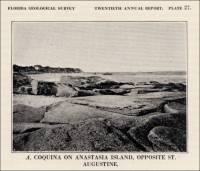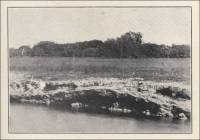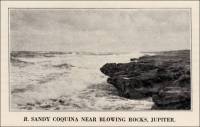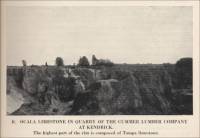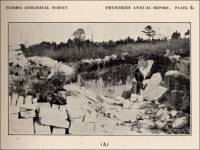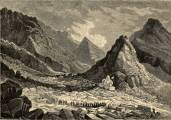


List of Quarries in Florida & Quarry Links,
Photographs and Articles
(The following list of Florida quarries is not a complete list of all of the historical quarries in the state, only the ones I have been able to locate. If you know of more historical quarries in Florida, please contact me. If you are looking for a specific old Florida stone quarry, feel free to contact me as I may have some material that has not been entered onto this web site yet. Peggy B. Perazzo)
- Quarries in Florida (present-day companies), listed on Superyellowpages.com.
- Anastasia Island, Florida - Coquina Quarry, Anastasia
Island (The following text and engravings were published
in “Scenes in Florida, in Picturesque America,
with Illustrations by Harry Fenn, 1872.) (Also see the section: St.
Augustine, Florida - the City of St. Augustine & the Fort
of San Marco in the Florida Structures section
of this web site.)
“The quaint little city of St. Augustine, Florida, the oldest European settlement in the United States, is situated on the Atlantic coast, in a narrow peninsula formed by the Sebastian and Matanzas Rivers, on the west side of a harbor which is separated from the ocean by the low and narrow island of Anastasia. It lies about forty miles south of the mouth of the great river St. John’s, and about one hundred and sixty miles south from Savannah, in Georgia.”
- Anastasia Island, Florida - Coquina/Limestone Quarries
(circa 1886). from Report of the United States
National Museum Under the Direction of the Smithsonian Institutions
For the Year Ending June 30, 1886, Chapter entitled “The
Collection of Building and Ornamental Stones in The U. S. National
Museum: A Hand-book and Catalogue,” By George P. Merrill,
Curator, pp. 393.
“On Anastasia Island, about 2 miles from Saint Augustine, there was formerly quarried to a considerable extent a very coarse and porous shell limestone which was used in the construction of the old city of Saint Augustine and of Fort Marion, which was built about the middle of the eighteenth century. The rock is composed simply of shells of a bivalve mollusk more or less broken and cemented together by the same material in a more finely divided state. Fragments of shells an inch or more in diameter occur. The rock is loosely compacted and very porous, but in a mild climate like that of Florida is nevertheless very durable. The quarries were opened upwards of two hundred years ago, but the stone is not now extensively used, owing in part to the dampness of houses constructed of it, and in part to the cheapness of wood. The rock, which is popularly known as Coquina (the Spanish word for shell), is of Upper Eocene age. In the quarries the stone lies within a few feet of the surface, and can be cut out with an ax, in sizes and shapes to suit.”
-
Anastasia Island, Florida – Coquina on Anastasia Island (Coquina) (from Geology of Florida, by C. Whythe Cooke and Stuart Mossom, from the Twentieth Annual Report of the Florida State Geological Survey, 1929, pp. 201. Courtesy of DEP’s Florida Geological Survey)
-
Brooksville (east of), Florida – the Camp Concrete Rock Company Tampa Limestone Pit (Limestone) (from Geology of Florida, by C. Whythe Cooke and Stuart Mossom, from the Twentieth Annual Report of the Florida State Geological Survey, 1929, pp. 87. Courtesy of DEP’s Florida Geological Survey)
(photo caption) Pl. 9-B. Tampa limestone in pit of the Camp Concrete Rock Company, 5 miles east of Brooksville. (pp. 87)
- Coleman (near), Florida – George R. Steinhauser – Rock Quarry (The following information is from an advertisement in Stone: An Illustrated Magazine, Vol. XLVI, No. 3, March, 1925, Stone Publishing Co., New York, pp 172.)
-
Coral Gables, Florida – Miami Oolite in Canal Bank (Oolitic Limestone) (from Geology of Florida, by C. Whythe Cooke and Stuart Mossom, from the Twentieth Annual Report of the Florida State Geological Survey, 1929, pp. 205. Courtesy of DEP’s Florida Geological Survey)
- Coral Gables, Dade County, Florida - Venetian Pool was built within a rock quarry (photograph and history) presented by the National Register of Historic Places Travel Itinerary. Click here to read “The History of Coral Gables Venetian Pool” about the history of the Venetian Pool.
- Dade County, Florida - Limestone Suitable for Construction Materials - Resources & Land Information for South Dade County, Florida (includes a map, presented in the “Mineral Resources - Economic Aspects” section of the U. S. Geological Survey web site)
- Daytona Beach, Florida - the Daytona
Beach Bandshell (history and photograph) Presented
by Volusia County Government. (The link from which the following information was obtained is no longer available.)
<http://echotourism.com/cultural/bandshell.htm>The Daytona Beach Bandshell “oceanfront amphitheater is composed of entirely of coquina rock, quarried from the Atlantic Ocean in neighboring Flagler County.”
- Enchanted Forest, Florida - Photographs of a Coquina Stone Quarry, presented on the Friends of the Enchanted Forest web site. (Scroll down to photos.)
- The Florida Keys - Lower Keys, Florida - The
Blue Hole at Big Pine Key.
(Scroll down to the “Blue Hole” entry.)
Rock from the old quarry was used to provide rock for construction of Henry Flagler's Florida East Coast Railway. It is now a home for water creatures.
- Florida - Mission
Indians Quarried Coquina Stone - “UF Researcher
Finds Mission Indians Played Bigger Role in Florida History,” by
Cathy Keen, presented as a news release by the University
of Florida.
“‘(Mission) Indians from northern Florida and southern Georgia literally provided the food and labor to sustain the Spaniards, even mining the coquina stone used to build the fort (the Castillo de San Marcos) in St. Augustine,’ he said.”
- Florida City (near), Florida – the Card Sound Quarry (Limestone)
- Florida City (near), Florida – the Cemex Card Sound Quarry (Limestone) (present-day quarry)
According to the Google + Profile page for the Card Sound Quarry, the address and phone number are given as: 15900 SW 408th St Homestead, FL 33034 (305) 790-6648. Web site: http://www.cemexusa.com/ProductsServices/Aggregates.aspx
- Florida City (near), Florida – the Cemex Card Sound Quarry (Limestone) (quarry history)
- Florida City (near), Florida – the Card Sound Quarry (Limestone) The mindatorg web site lists the Card Sound Quarry among the list of Florida quarries at this link:
-
Florida City (near), Florida – the RMC South Florida, Inc., Card Sound Quarry (Limestone) (quarry history) The USGS web site indicates that the company name of the Card Sound Quarry was RMC South Florida, Inc.
- Florida City (near), Florida – the Card Sound Quarry (Limestone) (quarry history)
- Florida City (near), Florida – the Cemex Card Sound Quarry (Limestone) (quarry history)
- Florida City (near), Florida – Cemex Construction Materials Florida, LLC, Card Sound Quarry (Limestone) (quarry history)
-
Florida City (near), Florida – Cemex Construction Materials Florida, LLC, Card Sound Quarry (Limestone) (quarry history)
The Miami-Dade, Florida, Hazardous Materials & Storm Surge Zones map dated August 6, 2015, lists Cemex as the Card Sound Quarry operator.
According to Industrial Minerals Industry Directory of Florida, Florida Geological Survey, Information Circular Ic-109, by S. M. Spencer, limestone was produced at the Card Sound Quarry in 1993.
The geoview.info web site includes a Google view of the quarry at the link below, although ownership of the quarry is not listed.
In Feb. 2012 Cemex USA was listed as winner of an award for Card Sound Quarry (Florida City)
This FindTheData web site indicates that in 2/2013 the crushed/broken limestone quarry was abandoned. In 2013 the operator CEMEX Construction Materials Florida, LLC / Office name: Bartow FL Field Office.
- Florida City (near), Florida – the Card Sound Quarry (Limestone) The mindatorg web site lists the Card Sound Quarry among the list of Florida quarries at this link:
- Florida Peninsula & the Ocala Platform, Citrus & Levy Counties, Florida - the Avon Park Formation Quarries (Marine Limestone with Dolostone), information and photograph by the Florida Geological Survey.
“New Companies - George R. Steinhauser, 6925 Michigan St., St. Louis, Mo., has acquired 50,000 acres near Coleman, Fla., and plans to equip a rock quarry.”
-
Fort Thompson, Lee County, Florida – Fresh-water Limestone Exposure (from Mineral Industries and Resources of Florida, by E. H. Sellards, From the Sixth Annual Report of the Florida State Geological Survey, pp. 21-114, 1914, Statistics on production collected in co-operation with the United States Geological Survey) (Courtesy of DEP’s Florida Geological Survey.)
-
Fort Thompson, Lee County, Florida – Limestone Exposure (from Mineral Industries and Resources of Florida, by E. H. Sellards, from the Sixth Annual Report of the Florida State Geological Survey, pp. 21-114, 1914, Statistics on production collected in co-operation with the United States Geological Survey) (Courtesy of DEP’s Florida Geological Survey.)
-
Hernando County, Florida – Brooksville Quarry (The following information is from “Brooksville’s Quarry Preserve Project Takes Another Step Forward,” by Carter Gaddis, January 26, 2010)
According to the 2010 article, “Brooksville’s Quarry Preserve Project Takes Another Step Forward”:
- Hialeah, Florida – the White Rock Quarries (present-day company) This web site offers a list of news articles and photographs relating to the company. (The quotation below is used with permission of The Vecellio Group / White Rock Quarries.)
-
Jackson County, Florida – Vicksburg Limestone in Jackson County (Limestone) (from Mineral Industries and Resources of Florida, by E. H. Sellards, From the Sixth Annual Report of the Florida State Geological Survey, pp. 21-114, 1914, Statistics on production collected in co-operation with the United States Geological Survey) (Courtesy of DEP’s Florida Geological Survey.)
- Jacksonville, Florida – the George W. Clark Co., Wholesalers of Wrought Steel Fences for the Trade, 50 Beekman St., New York, Jacksonville, Florida (Advertisement from The Monumental News, March, 1895, Vol. 7, No. 3, pp. 201)
- Jacksonville, Florida – the George W. Clark Company Building (from The Monumental News, Vol. XXI, No. 1, January 1909, pp. 50, 52) The George W. Clark Co. (“…marble works and yard are located near the building.”)
(From the “Among the Retail Dealers” section) “We recently described in these pages the handsome new building erected by the George W. Clark Co., Jacksonville, Fla., and we show here a picture of the structure which is one of the city’s finest business buildings. The company’s monument business is handsomely housed on the first floor and the rest of the building is rented for offices. Mr. George W. Clark of this firm has taken an active part in public affairs in Jacksonville, and the little cartoon of him reproduced herewith, appeared in a recent issue of the Jacksonville Times-Union, under the caption, ‘Men of Affairs in Jacksonville.’ Mr. Clark is president of the Main Street Improvement Association, an organization of property owners on this leading business street that have raised funds to make a brilliantly lighted thoroughfare of it by installing high power tungsten lights through the business center. Another recent cartoon of Mr. Clark represented him as turning on the light on the ‘Great White Way.’ The business of this firm is handled largely through agents; they have over five hundred agents in all parts of the United States selling their monumental work. They have a few in the West Indies, and one in Manila. This building was erected for the purpose of giving their business a permanent home. Two of the floors are used by them, while the balance is used as any other office building. It is equipped with freight and passenger electric elevators, steam heat and all other modern improvements. The main office, which is located on the ground floor, is arranged like a bank, with tile floors, office railing, etc. Their marble works and yard are located near the building. This is perhaps the best office building owned and occupied by any monumental firm in the country.”
- Jacksonville, Florida – the Jacksonville Undertaking
Company Marble Business (From Stone: An Illustrated
Magazine, Vol. XII, No. 1, December, 1895, “Notes
From Quarry and Shop” section, Stone Publishing Co., New
York, pp. 82.)
“The Jacksonville ( Fla.) Undertaking Company has gone into the marble business, and will shortly open.”
- Jacksonville, Florida – the Kingsley Plantation Slave Cabins (Kingsley Plantation State Historic Site). This web site was presented by Luxury Link. (The link from which the following information was obtained is no longer available.)
<http://www.luxurylink.com/portfolio/por_dest_guide.php?save=1&id=264265> - Jupiter, Florida – Sandy Coquina near Blowing Rocks, Jupiter (Coquina) (from Geology of Florida, by C. Whythe Cooke and Stuart Mossom, from the Twentieth Annual Report of the Florida State Geological Survey, 1929, pp. 201. Courtesy of DEP’s Florida Geological Survey)
According to this web site, the “...Avon Park Formation is composed of cream to light-brown or tan, Middle Eocene..., fossiliferous marine limestone interbedded with dolostone.” Exposures of this stone occur near the crest of the Ocala Platform in Citrus and Levy Counties throughout the Florida Peninsula and the eastern panhandle. The stone is composed of cream to light-brown or tan colors.
“Quarry Preserve, a proposed 5,800-home development north of Brooksville, cleared an important hurdle this month when the Hernando Board of County Commissioners voted 3-2 to send the plan to the Florida Department of Community Affairs for review….”
“The 4,280-acre limestone quarry was owned by Jacksonville-based Florida Rock Industries, which was purchased by Vulcan Materials Company in 2007. Varn said mining activity continues on about 150 acres of the land, but the land is expected to mined out long before the Quarry Preserve project would break ground in 2014 or 2015.”
"White Rock Quarries is one of South Florida's leading aggregate producers and one of the top three producing single-site quarries in the United States." The company began operation in 1986.
| Geo. W. Clark Co., Wholesalers of Wrought Steel Fences for the Trade, Florida and New York (advertisement) |  |
 |
 |
“Clark building, Jacksonville, Florida, home of George W. Clark Company” |
“Cartoon of George W. Clark from Jacksonville paper.” |
According to this web site, the slave cabins were constructed of local coquina stone.
-
Kendrick, Florida – the Cummer Lumber Company Quarry (Limestone) (from Geology of Florida, by C. Whythe Cooke and Stuart Mossom, from the Twentieth Annual Report of the Florida State Geological Survey, 1929, pp. 55. (Courtesy of DEP’s Florida Geological Survey)
- Lake Okeechobee, Florida – Limestone in Lake Okeechobee (from Mineral Industries and Resources of Florida, by E. H. Sellards, From the Sixth Annual Report of the Florida State Geological Survey, pp. 21-114, 1914, Statistics on production collected in co-operation with the United States Geological Survey) (Courtesy of DEP’s Florida Geological Survey.)
-
Lazy Lake, Broward County, Florida – the old Lazy Lake Rock Quarry
According to the “Lazy Lake” Florida, Wikipedia article, “In 1946, a developer and contractor by the name of Hal Ratliff, began the process of building the community around an old rock quarry (which later was filled with water and became the village’s artificial lake.)….”
- Marianna, Jackson County, Florida - Marianna Limestone Quarry, information and photograph by the Florida Geological Survey.
Note: I was unable to find out what kind of rock was quarried. If anyone has that information, please send me the type of rock and source of the information. Thank you, Peggy B. Perazzo
-
Marianna, Florida – the Chimney Rock Quarries (Limestone) (from Geology of Florida, by C. Whythe Cooke and Stuart Mossom, from the Twentieth Annual Report of the Florida State Geological Survey, 1929, pp. 59. Courtesy of DEP’s Florida Geological Survey)
- Mauthausen, Florida - South Wall of the Quarry at Mauthausen (photographs) presented by the University of South Florida, A Teacher's Guide to the Holocaust.
- Miami (northwest of), Florida - Ponce Products Corp.
Pennsuco Limestone Quarry (circa 1967) (From Mining
and Mineral Operations in the United States: A Visitor’s
Guide, by Staff, Bureau of Mines, Area Mineral Resource
Offices, U. S. Department of the Interior, Bureau of Mines,
1967, pp. 19.)
“U. S. 27. - Three miles northwest of Miami is Ponce Products Corp.’s Pennsuco Limestone quarry. Most mine and quarry operators fight hard to keep water out of their workings but, since the water table at the Pennsuco is almost at the surface, drilling and blasting is done under water. The broken rock is removed by dragline excavator and piled in windrows to drain. It is then moved to a plant for processing into aggregate and sand.”
-
Miami, Dade County, Florida – Miami Oolitic Limestone (from Mineral Industries and Resources of Florida, by E. H. Sellards, from the Sixth Annual Report of the Florida State Geological Survey, pp. 21-114, 1914, Statistics on production collected in co-operation with the United States Geological Survey) (Courtesy of DEP’s Florida Geological Survey.)
-
Miami (south of), Florida – Miami Oolite Deposit (Oolitic Limestone) (from Geology of Florida, by C. Whythe Cooke and Stuart Mossom, from the Twentieth Annual Report of the Florida State Geological Survey, 1929, pp. 205. Courtesy of DEP’s Florida Geological Survey)
- Milton (vicinity of), Florida - the
Arcadia Mill Complex, presented on the
University of West Florida, Anthropology web site.
There was once a sandstone quarry in the vicinity. According to this web site, “A mule drawn railroad and a sixteen-mile-long log flume provided means of transportation for the industries.”
- Naval Live Oaks Unit in Florida of the Gulf Islands National Seashore. View the National Park's Gulf Islands National Seashore official home page (including map) by clicking here. You can also view the Naval Live Oaks site presented by eHistory.com for history of the area and some photographs. Another online site indicates that the Old Quarry Trail is located in the northeast section, although it is not mentioned in the eHistory.com site.
- Near York, Florida - Old Limestone Quarries - "Serenity
replaces the hustle of old - Sunshine State finds farms, horses
and George Steinbrenner," by Bil Bowden, York
Daily Record staff. (The following quote is
used with the permission of the author, Bil Bowden.) "These
gentle grass-covered hills of north central Florida hide beautifully
the story of the small community of York that once thrived here..Gone
is the Ocala Silver Springs and Gulf Railroad, which served
as the town's lifeline to the outside world. Gone, too,
are the general store, the sawmill, the hotel and almost 200
York residents. Hidden back in the hills are limestone quarries,
which became York's main industry once the land was stripped
of its timber.." (The link from which the above quotation
was taken is no longer available for free. You can contact the
newspaper and obtain a copy of the article for a fee.)
<http://www.ydr.com/yorks/florida.shtml> - North Central Florida, the Central Gulf Coast Area, and Northwest Florida - Chert Quarries produced stone for tool manufacture during the Paleoindian Period, presented by Florida Department of State, Division of Natural Resources. (This link is no longer available.) <http://www.dos.state.fl.us/dhr/bar/hist_contexts/paleo.html#quarries>
- North
East Florida Bay - Windley Quarry (U.S. Geological
Site)
- Photograph of Quarry Cutter (Scroll down to small image and enlarge.)
-
North New River Canal, Florida – Limestone in the Everglades (from Mineral Industries and Resources of Florida, by E. H. Sellards, From the Sixth Annual Report of the Florida State Geological Survey, pp. 21-114, 1914, Statistics on production collected in co-operation with the United States Geological Survey) (Courtesy of DEP’s Florida Geological Survey.)
-
Ocala, Florida – the Florida Lime Company Limestone Pit (Limestone) (from Geology of Florida, by C. Whythe Cooke and Stuart Mossom, from the Twentieth Annual Report of the Florida State Geological Survey, 1929, pp. 53. Courtesy of DEP’s Florida Geological Survey)
- Ocala (near), Florida - Mining of Limerock Near Ocala,
Florida
Limerock deposits near Ocala are among the most abundant in the nation. The limestones of Florida are of vast importance, contributing generously to its development in supplying material so extensively used in road construction, concrete aggregate, ballast, lime and cement manufacture and also as a building material.
-
Ocala, Florida – Vicksburg Limestone (from Mineral Industries and Resources of Florida, by E. H. Sellards, from the Sixth Annual Report of the Florida State Geological Survey, pp. 21-114, 1914, Statistics on production collected in co-operation with the United States Geological Survey.) (Courtesy of DEP’s Florida Geological Survey.)
-
Ocala, Florida – the Limestone Quarry (Limestone) (from Geology of Florida, by C. Whythe Cooke and Stuart Mossom, from the Twentieth Annual Report of the Florida State Geological Survey, 1929, pp. 55. (Courtesy of DEP’s Florida Geological Survey)
- Orient (near), Florida –Tampa Limestone Deposit on Six Mile Creek at Orient (Limestone) (from Geology of Florida, by C. Whythe Cooke and Stuart Mossom, from the Twentieth Annual Report of the Florida State Geological Survey, 1929, pp. 87. Courtesy of DEP’s Florida Geological Survey)
- Plantation Key Colony, Monroe County, Florida - Plantation Key Quarry Photographs in the “Rock Quarries” section of the Keys Historeum web site presented by Historical Preservation Society of the Upper Keys.
- River Junction (near), Florida – Exposure of the Chattahoochee Limestone Formation (from Mineral Industries and Resources of Florida, by E. H. Sellards, From the Sixth Annual Report of the Florida State Geological Survey, pp. 21-114, 1914, Statistics on production collected in co-operation with the United States Geological Survey) (Courtesy of DEP’s Florida Geological Survey.)
- St. Augustine, St. Johns County, Florida - Anastasia Island
- Coquina
Limestone Quarry (history)
Coquina is St. Augustine’s most famous stone; and it has
a history, by Margo C. Pope, the St.
Augustine Record (staugustine.com),
March 12, 2000. The coquina stone was used in building the Castillo
de San Marcos, which was built from 1672 and 1695.
(The link from which the above information was obtained
is no longer available.)
<http://www.staugustine.com/stories00/031200/coquina.shtml>- You can view some photographs of coquina
stone (the native shell rock) on the “Architecture
and Construction” section of the National Park Service’s
web site about the architecture and construction of the Castillo
de San Marco. Coquina, the native shellrock was quarried
on Anastasia Island and transported to the building site for
the construction of the Castillo. It was soft when quarried
but hardened after the rock dried.
- Anastasia State Recreation Area, Florida State Parks - Photographs and history of the area and Coquina Limestone Quarry industry.
-
Anastasia Island, St. Augustine, Florida – “Coquina Quarry – Spanish Ruins,” presented by Dr. Bronson (photographs and history)
- You can view some photographs of coquina
stone (the native shell rock) on the “Architecture
and Construction” section of the National Park Service’s
web site about the architecture and construction of the Castillo
de San Marco. Coquina, the native shellrock was quarried
on Anastasia Island and transported to the building site for
the construction of the Castillo. It was soft when quarried
but hardened after the rock dried.
- St. Johns County to Palm Beach County & Inland,
Florida - Anastasia
Formation Coquina Quarries, information and photograph
by the Florida Geological Survey.
According to this web site, the Anastasia Formation Coquina “is composed of Pleistocene...interbedded sands and coquinoid limestones.” The color is described as an orangish brown “consisting of whole and fragmented mollusk shells in a matrix of sand, cemented by calcite.” For over 400 years coquina has been used as a building stone in Florida. You can read more about the locations of the exposures at the link above.
- Windley Key, Florida – Key
Largo Limestone Quarry at Windley Key Fossil Reef Geological
State Park (The link from which the following information was obtained is no longer available, although you can view the article on the Internet Archive Wayback Machine.)
<http://www.floridastateparks.org/windleykey/default.cfm>According to this web site, Henry Flagler began quarrying Key Largo Limestone at Windley Key during the early 1900s. Key Largo limestone is fossilized coral. After purchasing the land, the Florida East Coast Railroad used the stone to build Henry Flagler’s Overseas Railroad in the early 1900s and completed in 1912. The limestone was used to fill for railroad beds and embankments. From that time until the 1950s the quarry produced decorative stone called “Keystone.”
Visitors at the Geological State Park can still walk along the “eight-foot-high quarry walls to see cross sections of the ancient coral and learn about the quarry and its operation.” Visitors can also view quarry machinery that has been preserved at the park.
Also according to this web site, “This keystone, a decorative building stone, can be seen on several buildings throughout the United States including the St. Louis Post Office, an altar in a New York City chapel and many other locations. Local examples include the Alison Fahrer Environmental Education Center at Windley Key and the Hurricane Monument located in the center of Islamorada.”
- Buildings and Building Stone - Coquina in Castillo de San Marcos (photographs and geology info.), St. Augustine, Florida, U.S.A., presented by Bruce Railsback, Professor, Department of Geology, University of Georgia.
- History of Windley Key, presented by Jerry Wilkinson on the KeysHistory.com web site.
-
“Key Largo Limestone Quarry at....,” photographs by JE, presented on flickr.
- Pleistocene coral reef: Windley Key Quarries, Florida Keys (photographs & geology), by Dr Roger J Suthren, Geology, Oxford Brookes University; LTSN-GEES Subject Centre, UK.
-
Windley Keys Quarry Photographs – Google Images
- Windley Keys Quarry Photographs in the “Rock Quarries” section of the Keys Historeum web site presented by Historical Preservation Society of the Upper Keys.
- Windley Key, Florida – the Key Largo Rock Quarry Inc. Coral Quarry & Finishing Plant (Coral) (photographs and history), presented in the Upper Keys Stone Quarries in the Industries Room of the Keys Historeum web site. This web site is presented by the Historical Preservation Society of the Upper Keys.
- History of Windley Key, presented by Jerry Wilkinson on the KeysHistory.com web site.
- Windley Key, Florida – the Keystone Rock Company “Block-type” Coral Quarry (Coral) (photographs and history), presented in the Upper Keys Stone Quarries in the Industries Room of the Keys Historeum web site. This web site is presented by the Historical Preservation Society of the Upper Keys.
- Windley Key, Florida – the Russell Quarry (Coral “Slab”) (photographs and history), presented in the Upper Keys Stone Quarries in the Industries Room of the Keys Historeum web site. This web site is presented by the Historical Preservation Society of the Upper Keys.
The Marianna Limestone was quarried near Marianna, Florida, in the past for use as building stone. The color of the stone ranges from white to cream, and it is fossiliferous, variably argillaceous marine limestone occurring in the central panhandle.
(photo caption) Pl. 9-A. Tampa limestone on Six Mile Creek, a quarter of a mile below the bridge at Orient.
| Fig. 17. Exposures of the Chattahoochee formation in cut of the Atlantic Coast Line Railroad near River Junction. (pp. 55) | 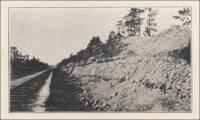 |
According to this web site, “…The end product, decorative and ornamental stone, was now made on site instead as in years past in Miami. The quarry closed in 1968.” This section also includes several photographs of the quarry and finishing plant and photographs of some of the remaining equipment in the 1990s.
According to this web site, this quarry “was operated by Charles Cale Sr. for the Keystone Rock Company.” You can view photographs of equipment working in the Russell Quarry on “The Rock Quarry Case - Page 3.”
-
Windley Key, Florida – the World War I Veterans Coral Quarry (Coral) (photographs and history), presented in the Upper Keys Stone Quarries in the Industries Room of the Keys Historeum web site. This web site is presented by the Historical Preservation Society of the Upper Keys. (The Florida East Coast Railway Company is mentioned.)
Commercial use of material within this site is strictly prohibited. It is not to be captured, reworked, and placed inside another web site ©. All rights reserved. Peggy B. and George (Pat) Perazzo.


